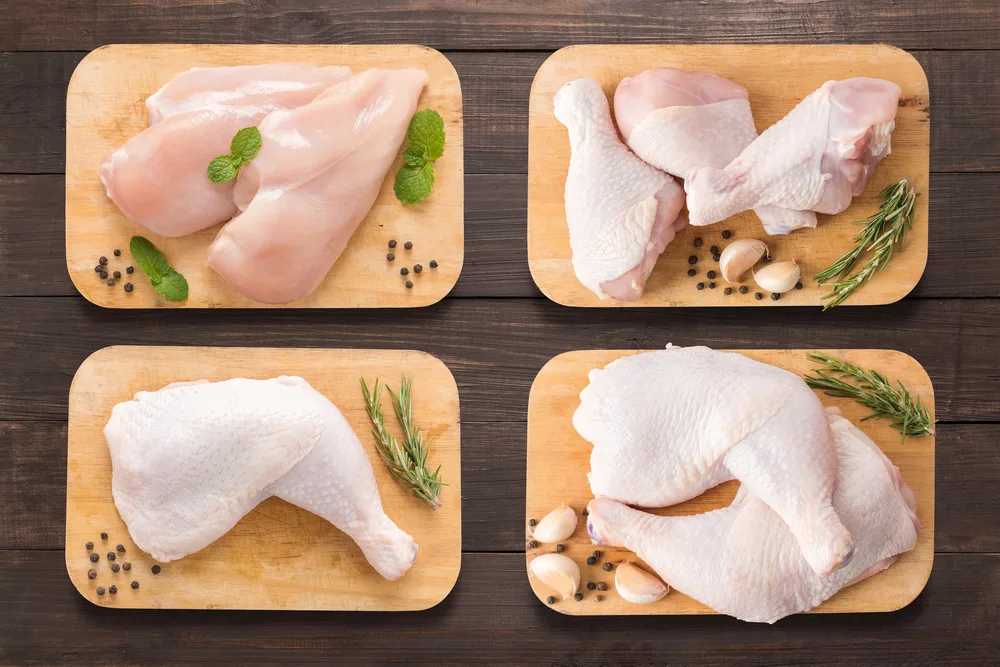Last Updated on 17th December 2021 by
Each part of the chicken has its own attributes, and knowing how to cook the different parts, how to use them, and how they taste will help you to make the most of your chicken dishes. Because the different parts of the chicken can have varying textures and tastes, it’s important to know how to season them and prepare them to take advantage of their differences.
While the chicken breast and chicken thigh can be very similar in size and even appearance, there are distinct differences you should know about. Let’s look at some of those differences so that you can make the best use of these different cuts of chicken meat.
What are the Key Differences Between Chicken Breast and Chicken Thigh?
1. The Cuts are from Different Locations of the Chicken
The thigh and breast come from different parts of the chicken body. The breast is the chicken’s chest, and it is typically the largest cut of meat on the chicken. When buying a chicken cut into parts for cooking, you will usually find four different types of parts- breast, thigh, legs, and wings.
The breast comes from the forward part of the chicken, while the thighs are connected to the lower end of the breast and connected to the legs as well. Where some people can get confused with these two cuts of meat is their size and similar appearance.
These are the two largest cuts of meat on a chicken, in most cases, and their shape can even be a little similar. That’s especially true if they’ve been breaded already. It can be difficult to tell the difference between the thigh and the breast when there’s heavy breading.
2. The Cuts Have Different Textures
People tend to have preferences as to which cut of chicken meat they like. Some people prefer what’s called light meat or white meat. This is the breast and wing. The texture of the lighter chicken meat can become dry, especially if you overcook it. It’s made of about 10% red fibers, and that gives it a distinct quality and texture.
The dark meat is made from about 50% red fibers and consists of the chicken legs and thighs. This is a kind of meat you can cook for longer without it drying out. It tends to be not as tough as white meat and more succulent and juicier. The dark meat is usually very tender, so a lot of kids will prefer the dark meat for this reason. It’s easier to bite through and doesn’t take as much work to gnaw the meat apart or to take it off the bone. It tends to fall off the bone more easily than light meat. That light meat of the breast and wing can be a little tough to tear away from the bone.
3. Each Cut Has a Different Flavor
Because there’s a different level of fibrousness in the different cuts of chicken meat, you’re going to have different flavor. That varying texture helps create a different type of flavor as well. Light meat tends to have a mild flavor, which means it benefits from some heavy seasoning to bring out its subtle taste.
Darker meat is juicier and more flavorful naturally. Some people don’t even add any seasoning to dark meat because of how rich its flavor already is. The main reason many people prefer one kind of meat over other is because of its natural flavor.
The milder flavor of the white meat allows it to accommodate seasoning better. Darker meat in the legs and thighs already has a strong flavor of its own, which can make it a little trickier to season. You’ll have to work with the flavor that’s already there.
Is Chicken Breast or Chicken Thigh Healthier?
A lot of people will tell you that white meat from the chicken breast is healthier than dark meat from the thighs. There’s some truth to that. The breast meat has fewer calories than thigh meat, but not much. It’s just a difference of three calories.
The difference comes in the fat content of these two meats. Dark thigh meat has much more saturated fat then the white breast meat. You’ll find three extra grams of fat for every 100 grams of meat in the dark meat, and then twice as much saturated fat in thigh meat as in breast meat. So, if you’re looking for a slimmer meat that’s better for a weight loss program, breast meat is the way to go.
There’s more protein in white meat than what you’ll find in the thigh of the chicken. However, dark meat has more vitamin C, zinc, and iron. On the other hand, white meat has more vitamin B6 and more vitamin B3 than dark meat. Consider all these different benefits as you compare the two meats. There’s nutritional value in both of them, but white meat definitely edges out dark when it comes to which one is healthier.
There’s a range of nutrients available in both cuts of meat, so if you’re wanting all the benefits that chicken meat has to offer, you should be eating both thighs and breasts.
However, if you’re looking to lose weight, you may want to stick to chicken breasts. To additionally cut down on fat content in chicken, be sure to take off the skin before cooking it. The skin adds a lot of fat to the chicken, and some of that can seep in. It’s probably not a good idea to leave the skin on while cooking and then take it off after the chicken is done cooking, if you’re looking to cut your calories as much as possible.
How to Cook Chicken Thighs and Breasts
There are differences when you cook thigh and breast meat as well. You want to be careful about how long you cook them because you can dry out either of these cuts of meat by overcooking. It’s easier to dry out the breast meat, however, since it’s already naturally drier and less juicy than the dark meat.
If you want to get the chicken to come out perfectly, with a juicy and tender texture and plenty of flavor, you’ll have to be careful about overcooking it, and you may want to cook breasts and thighs separately. Another way to make this work is to cook them together but keep them separated on your baking dish, and then pull out the breast before the thighs.
This way, the thighs will cook a little longer and neither of the cuts of meat will dry out.
If you really want to make your chicken extra juicy, leave the skin on. That fatty layer of skin adds a lot of flavor to the chicken, especially on the outside. Peeling off the skin can reduce the fat, for sure, but it also takes away a lot of the natural flavor of the chicken.
These two cuts of meat are different in a lot of ways, as you can see. Those differences add up when it comes to nutritional value, fat content, how they’re cooked, how they taste, and how you season them.
Keep all of this in mind as you choose the right kind of chicken for your meal or diet plan. These factors also affect what seasonings you should use with them and how you’re going to want to cook them when you prepare a meal.
I'm Pauline, a mother of four grown children, my passion for cooking stemmed from the joy i get cooking for my family. I love to try new dishes, especially when dining out but creating and sharing my own recipes is my favourite thing to do!



b^onus de registro na binance
Sunday 23rd of February 2025
Thank you for your sharing. I am worried that I lack creative ideas. It is your article that makes me full of hope. Thank you. But, I have a question, can you help me?
aenean
Friday 21st of February 2025
YH5PhnGL6Lv